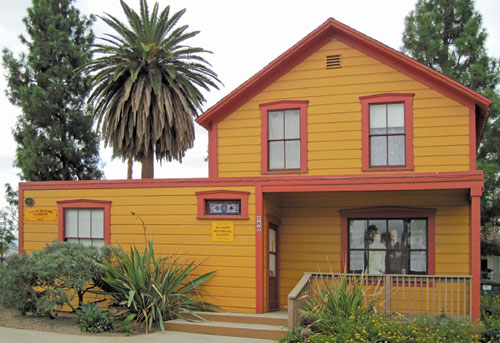

| EXTERIOR COLORS OF KNOX HOUSE MUSEUM |
| by Eldonna Lay, Curator |
| As long-time curator of the Knox House Museum – and the one initiating the color contest for the era-authentic color of the hotel/home of city founder Amaziah Lord Knox – I am delighted to explain the background of the color choices. |
| When the Knox needed repainting, we on the El Cajon Historical Society board decided to devote considerable research to the colors used on buildings in the year 1876, which – even here on America’s last frontier – was heavily influenced by Britain’s Queen Victoria’s use of elaborate and garish color combinations. Restricted by the lack of commercially colored paint, people in those days had to blend their own paints. Mainly, they used basic white milk paint and added vegetable colorings to turn it into black, brown and barn red. But when colored OIL-based paint became available in the late 1860s, AND when the extension of railroad tracks made it possible to have it shipped, Americans went sort of crazy, painting new buildings and repainting old in a combination of sometimes discordant hues (note San Diego’s own Villa Montezuma, those in Old Town’s neighboring Heritage Park and entire towns and cities throughout California and the nation. |
| So, wanting to examine an appropriate choice of colors, I (a historian with majors in both History and English, with a minor in Art, from Michigan State University) took a special committee from our board on tours of historic houses in San Diego. Then I prepared a rather lengthy packet of colored photos of Victorian houses, art history of the era, color boards and a list of research requirements to the board of El Cajon’s own Art Association – at the time, they had a marvelous gallery on Main Street across from City Hall). Thirteen members submitted paintings, which we had judged by a panel of prominent art history and architectural history experts. One historical architect was well-known throughout California, another was a “home-section” reporter from the “Union-Tribune”, a third was a San Diego architect who specialized in restoring historic buildings, and Karna Webster, an East County authority on historic homes and author of the SANDAG book on historic homes in El Cajon and of two new books on the El Cajon cemetery and another tracing the sales and re-sales of the Knox Hotel/house. The painting selected by these knowledgeable experts was based on the authenticity of the era painted by Gloria Chadwick, a highly respected, long-time local artist. |
| Now, was this combination the original color of Amaziah’s hotel/house? With only black and white photos from the 1800s to guide us, we’d submitted paint scrapings to Bruce D. Coons, long-time preservation specialist and president of Save Our Heritage Society for the City of San Diego. It was his opinion that if the building was painted at all, it was probably white-washed to protect it against the elements. And it was the opinion of our experts that public historic buildings had to be MORE than authentic ... they had to stand out AS ERA-RELATED PUBLIC buildings – thus the panel’s enthusiastic selection of Chadwick’s Victorian colors. |
| In fact, that painting will be hung in the lobby of El Cajon’s new El Cajon Brewery/pub restaurant on Magnolia and Main (2011) – along with greatly enlarged and muralized photos of the-then-village’s settlers on their walls, with a special collection of leading settler leaders within our city and the “rim” and county areas bearing El Cajon addresses, thus, the gaudy colors. Incidentally, Amaziah’s photo as a young man and a write-up about him is on posts of the relatively new metal city sign spanning Main Street near Magnolia Avenue. |
| So, while I and the historical society board are sorry that some people don’t like the Knox’s colors, you simply can’t imagine how that mustard yellow and maroon trim have improved people’s notice of the museum. To us, this is invaluable as we want people to come inside and see for themselves how well-built this old Victorian/Edwardian structure, built by New Englander Amaziah Knox, has held up. We’re eager to show what settlers brought with them to post-Civil War San Diego County – not jolted around in covered wagons, but shipped professionally aboard ships, or crated up and sent by wagon from San Francisco or aboard packet boats, among them (the “Harvard” or the “Yale”) – and later by rail to Los Angeles, then by commercial wagons. Through their belongings, we know their tastes, how much they could afford, their special interests, where they came from and their level of education. |
| Let us share with you our pride in those stalwart, energetic, forward-thinking folks who left the old behind to create new realities for themselves ... and left so much of it and themselves behind for us to appreciate and study. |
|
Note: Lay was designated by Supervisor Dianne Jacob to serve as a member of the San Diego County Historic Sites Board and served also on the City of El Cajon/CDC’s Design Review Commission for its Redevelopment area.
|
All Rights Reserved
2011 El Cajon Historical Society
2011 El Cajon Historical Society
